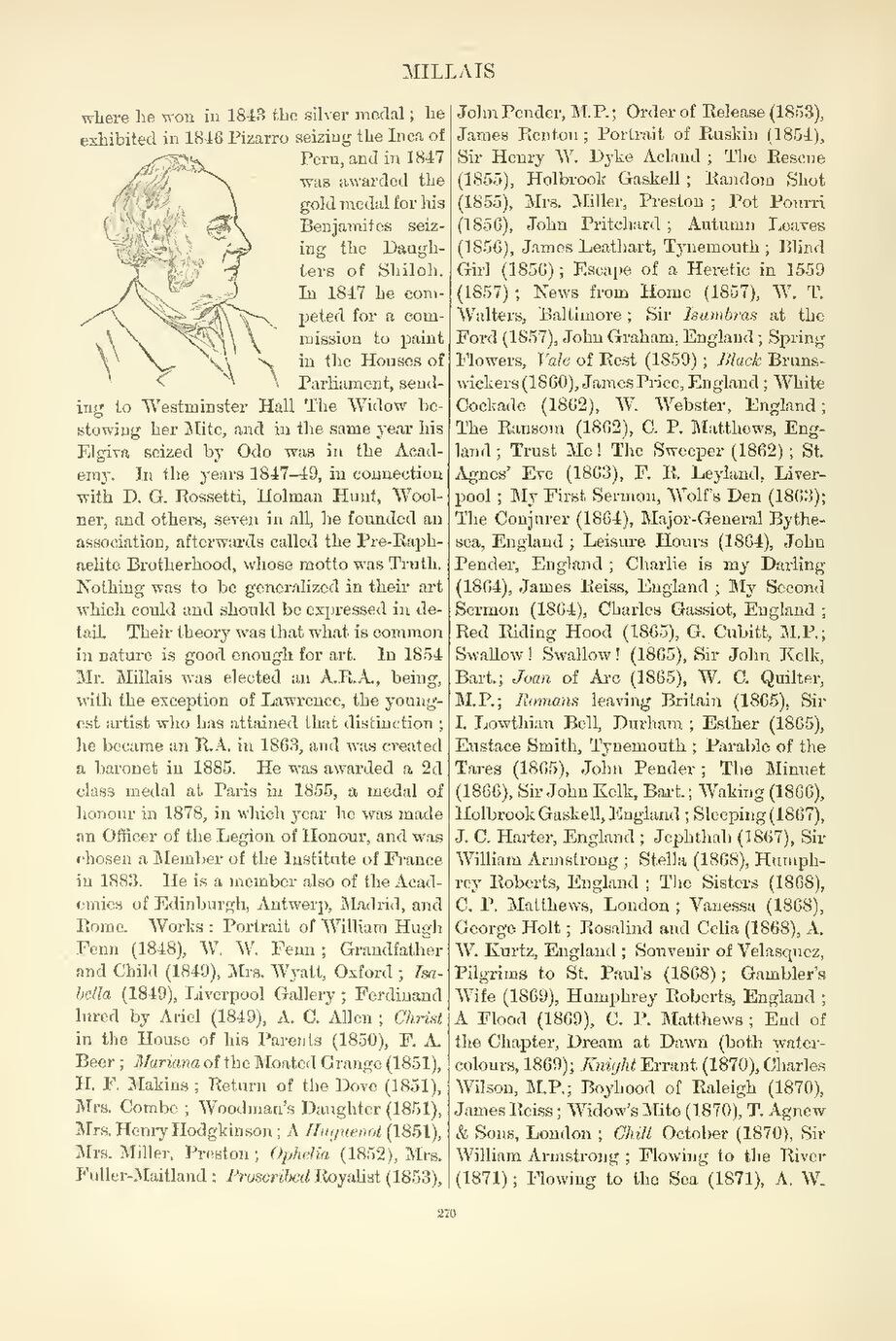An image should appear at this position in the text. To use the entire page scan as a placeholder, edit this page and replace "{{missing image}}" with "{{raw image|Cyclopedia of painters and paintings (IA cyclopediaofpain03cham).pdf/292}}". Otherwise, if you are able to provide the image then please do so. For guidance, see Wikisource:Image guidelines and Help:Adding images. |
where he won in 1843 the silver medal; he
exhibited in 1846 Pizarro seizing the Inca of
Peru, and in 1847
was awarded the
gold medal for his
Benjamites seizing
the Daughters
of Shiloh.
In 1847 he competed
for a commission
to paint
in the Houses of
Parliament, sending
to Westminster Hall The Widow bestowing
her Mite, and in the same year his
Elgiva seized by Odo was in the Academy.
In the years 1847-49, in connection
with D. G. Rossetti, Holman Hunt, Woolner,
and others, seven in all, he founded an
association, afterwards called the Pre-Raphaelite
Brotherhood, whose motto was Truth.
Nothing was to be generalized in their art
which could and should be expressed in detail.
Their theory was that what is common
in nature is good enough for art. In 1854
Mr. Millais was elected an A.R.A., being,
with the exception of Lawrence, the youngest
artist who has attained that distinction;
he became an R.A. in 1863, and was created
a baronet in 1885. He was awarded a 2d
class medal at Paris in 1855, a medal of
honour in 1878, in which year he was made
an Officer of the Legion of Honour, and was
chosen a Member of the Institute of France
in 1883. He is a member also of the Academies
of Edinburgh, Antwerp, Madrid, and
Rome. Works: Portrait of William Hugh
Fenn (1848), W. W. Fenn; Grandfather
and Child (1849), Mrs. Wyatt, Oxford; Isabella
(1849), Liverpool Gallery; Ferdinand
lured by Ariel (1849), A. C. Allen; Christ
in the House of his Parents (1850), F. A.
Beer; Mariana of the Moated Grange (1851),
H. F. Makins; Return of the Dove (1851),
Mrs. Combe; Woodman's Daughter (1851),
Mrs. Henry Hodgkinson; A Huguenot (1851),
Mrs. Miller, Preston; Ophelia (1852), Mrs.
Fuller-Maitland; Proscribed Royalist (1853),
John Pender, M.P.; Order of Release (1853),
James Renton; Portrait of Ruskin (1854),
Sir Henry W. Dyke Acland; The Rescue
(1855), Holbrook Gaskell; Random Shot
(1855), Mrs. Miller, Preston; Pot Pourri
(1856), John Pritchard; Autumn Leaves
(1856), James Leathart, Tynemouth; Blind
Girl (1856); Escape of a Heretic in 1559
(1857); News from Home (1857), W. T.
Walters, Baltimore; Sir Isumbras at the
Ford (1857), John Graham, England; Spring
Flowers, Vale of Rest (1859); Black Brunswickers (1860),
James Price, England; White
Cockade (1862), W. Webster, England;
The Ransom (1862), C. P. Matthews, England;
Trust Me! The Sweeper (1862); St.
Agnes' Eve (1863), F. R. Leyland, Liverpool;
My First Sermon, Wolf's Den (1863);
The Conjurer (1864), Major-General Bythesea,
England; Leisure Hours (1864), John
Pender, England; Charlie is my Darling
(1864), James Reiss, England; My Second
Sermon (1864), Charles Gassiot, England;
Red Riding Hood (1865), G. Cubitt, M.P.;
Swallow! Swallow! (1865), Sir John Kelk,
Bart.; Joan of Arc (1865), W. C. Quilter,
M.P.; Romans leaving Britain (1865), Sir
I. Lowthian Bell, Durham; Esther (1865),
Eustace Smith, Tynemouth; Parable of the
Tares (1865), John Pender; The Minuet
(1866), Sir John Kelk, Bart.; Waking (1866),
Holbrook Gaskell, England; Sleeping (1867),
J. C. Harter, England; Jephthah (1867), Sir
William Armstrong; Stella (1868), Humphrey
Roberts, England; The Sisters (1868),
C. P. Matthews, London; Vanessa (1868),
George Holt; Rosalind and Celia (1868), A.
W. Kurtz, England; Souvenir of Velasquez,
Pilgrims to St. Paul's (1868); Gambler's
Wife (1869), Humphrey Roberts, England;
A Flood (1869), C. P. Matthews; End of
the Chapter, Dream at Dawn (both water-colours,
1869); Knight Errant (1870), Charles
Wilson, M.P.; Boyhood of Raleigh (1870),
James Reiss; Widow's Mite (1870), T. Agnew
& Sons, London; Chill October (1870), Sir
William Armstrong; Flowing to the River
(1871); Flowing to the Sea (1871), A. W.
